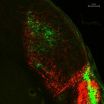"The ability to tolerate aggression is passed on across generations; there is genetic variation in the ability to tolerate aggression," said the study co-author Daniel T. Blumstein, professor and chair of ecology and evolutionary biology at UCLA.
Blumstein, a leader in the field of applying social network statistics to animals, and his colleagues studied four groups of yellow-bellied marmots, which are related to squirrels, over six years in the Rocky Mountains of Colorado. Each group included 15 to 30 marmots.
To study the social behavior of the animals, the biologists applied the same type of social network statistics that Google and Facebook use to study human behavior.
"We are gaining a novel insight into the importance of tolerating aggressive interactions," Blumstein said. "Those relationships are important for social stability and reproductive success. I believe these ideas are generalizable well beyond marmots."
The research, funded by the National Science Foundation and the National Geographic Society, is currently published in the online early edition of the journal Proceedings of the National Academy of Sciences and will appear Dec. 14 in the journal's print edition.
The paper's lead author, Amanda Lea, a former UCLA honors student who is now a research assistant in ecology and evolutionary biology, spent two summers observing the marmots for four hours a day and analyzing their behavior — from far enough away not to affect it. She can tell the marmots apart.
"We found that having many friendly interactions gave marmots fitness benefits — these marmots reproduced more. But surprisingly, we found that marmots embedded in a network of unfriendly interactions also showed higher fitness levels," Lea said. "Over a lifetime, a marmot that is very social will have more offspring than a less social one. But surprisingly, so will a marmot that is getting picked on frequently."
"The family unit is important, even if their interactions are not always nice," Blumstein said of the finding.
Like people, some marmots are quite friendly, some keep to themselves and some are more aggressive, Lea said. They live in family groups, groom one another, sit next to one another, play together and, much less frequently, fight. They live up to 15 years, Blumstein said.
Female marmots typically have three to nine offspring a year and can have as many as 60 over a lifetime. Some males can have as many as 150 or more, although most have many fewer, Blumstein said.
Blumstein, Lea and colleagues applied social networking statistics, computational analysis and quantitative genetics to marmots' social behavior. They studied, for example, whether interactions were friendly or aggressive, and they applied state-of-the-science statistical techniques to estimate the heritability of traits and whether particular traits are correlated with reproductive success.
With his colleagues, Blumstein, who has studied marmots for more than 20 years to learn about their biology and evolution, quantified the genetic component to the marmots' social behaviors. Genetic factors account for some 10 percent of the differences among marmots, while about 20 percent of the variation is due to the social environment, they calculated.
"There is a genetic component to certain social behaviors, and we have quantified that," Blumstein said.
Because social behavior has a genetic component, he said, a social trait has the ability to carry on across generations and evolve.
"Social network statistics can be a useful way to study a variety of animals and understand social evolution," Blumstein said. "This study says that traits we define using social network analyses can evolve, and that has not been demonstrated like this before."
The life scientists made predictions and found some surprising results.
"We predicted that direct and immediate relationships, over which an individual has control, might have a higher heritability (a genetic basis) than indirect relationships," Blumstein said.
"We found that direct measures were heritable and indirect measures were not; we expected this," he said. "However, within these direct relationships, you might expect that things I do to you, things I have control over, would have significant heritability, but what we found is the opposite: the ability to tolerate aggression is heritable, and we found that fascinating. Tolerating aggression is, surprisingly, very important in marmots and perhaps in other species."
"Many people have perhaps not recognized the benefits of aggressive interactions, even if you are on the receiving end," Lea said.
Blumstein said the findings have important implications for why animals are social.
These marmots in Colorado have been studied since 1962 — one of the longest-running animal studies. Blumstein has studied marmots worldwide, and these for more than a decade.
"Once we had a good genealogy, a good understanding of the genetic relationships among them, we were able to ask questions about the heritability of various behaviors — the ability of a behavior to be passed on from generation to generation," he said.
Why has Blumstein devoted so much of his research to studying these animals?
"Most species do not have an address, but marmots do, and because they have an address, you can set up camp and study them," he said. "You can go to their burrows every day and watch them. We can learn a lot about evolution, the adaptive value of sociality and the adaptive value of complex communication by studying marmots and ground squirrels."
INFORMATION:
Co-authors on the Proceedings of the National Academy of Sciences paper are Tina Wey, a UCLA graduate student in Blumstein's laboratory, and Julien Martin, a postdoctoral scholar in Blumstein's laboratory.
UCLA is California's largest university, with an enrollment of more than 38,000 undergraduate and graduate students. The UCLA College of Letters and Science and the university's 11 professional schools feature renowned faculty and offer 328 degree programs and majors. UCLA is a national and international leader in the breadth and quality of its academic, research, health care, cultural, continuing education and athletic programs. Six alumni and five faculty have been awarded the Nobel Prize.
For more news, visit the UCLA Newsroom and follow us on Twitter.
END
